Top 10 Rarest Fruit In The World That You Have Probably Never Tried
Fruits are essential for everyone, be it a child, adult, or old. They contain vitamins and minerals to keep our bodies healthy. Not only this, if you skip a meal and eat a bowl full of fruits, then it will give the same amount of energy and fiber, in fact even more!
Having fruits in your diet can reduce obesity, blood pressure, and cholesterol. Fruits prevent diseases caused by the deficiency of vitamins.
The common vitamins present in fruits include vitamins A, C, and E, zinc, magnesium, folic acid, and phosphorus. If you make a habit of eating fruits daily, then it will build a robust immune system, and your life will be free of diseases in the future.
Sweet like Rambutan or sour like Buddha’s hand, each fruit has its unique characteristics and health benefits. Some fruits even show anti-cancer properties as well. Nowadays, people have become more inclined towards highly processed fats, and these products are high in calories and are loaded with artificial items which harm the body.
One should realize the importance of having fruits and even try out eating different kinds of fruits. If you eat fruits daily, you will notice the health changes in yourself. You must know the common fruits like bananas, apples, mangoes, etc., and their health benefits. But have you ever heard of the importance of eating Tamarillo or Red Banana?
All the fruit lovers want to try out new fruits now and then. They are exploring new, unique, and healthy fruits to include in their diet. Nature has bestowed us with many different types of fruits in other parts of the world.
Here is a list of the top 10 rarest fruit in the world. Try out these new varieties of fruits and see their health benefits yourself.
10. Red Banana

You must have eaten a Banana, which is usually yellow. But have you ever heard of red banana? Red bananas, native to Southeast Asia, have a sweet flavor like regular yellow bananas but have a slight taste of raspberry.
They contain carotenoid- a pigment that gives the peel a red color. Not only are they used in desserts, but they provide excellent nutritional benefits too.
- Rich in potassium, magnesium, Vitamin B6, and fiber, red banana helps maintain heart health by reducing blood pressure.
- They help to keep the eyesight strong.
- They contain higher amounts of antioxidants as well as Vitamin C as compared to regular yellow bananas.
- They help to keep the digestive system strong and also increase immunity.
9. Mangosteen
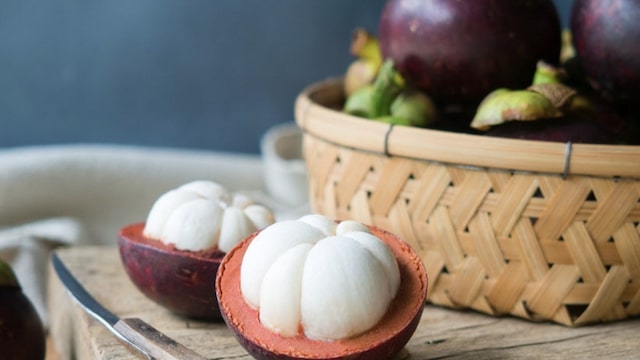
Mangosteen, or ‘Queen of Fruits,’ is a sweet and sour-taste fruit grown in various parts of Southeast Asia, and Mangosteen is Thailand’s national fruit. It is purple outside with juicy white flesh inside, and it is believed that Mangosteen was Queen Victoria’s favorite fruit.
Here’s is the benefits of this fruit that can help in multiple ways:
- Rich in antioxidants, this fruit prevents cancer and heart disorders along with treating urinary problems and diarrhea.
- The sour taste of Mangosteen is due to the presence of Vitamin C, which helps to keep the immune system strong.
- It reduces the cholesterol level in your body and promotes heart health.
- Due to its antibacterial properties, this fruit can treat many skins related issues like aging, wrinkles, and acne.
- The fruit helps in weight loss as well.
8. Akebia
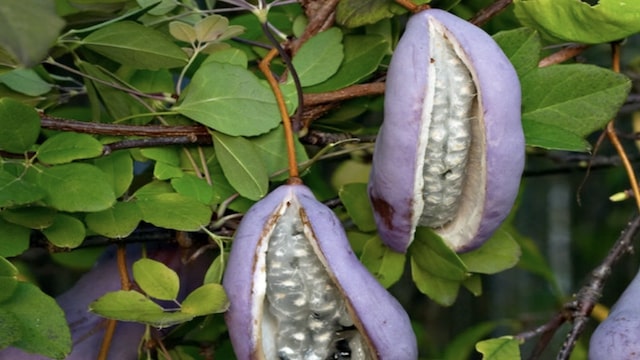
Purple Akebia was initially found to be grown in wild forests along the mountainsides in Japan. They were regarded as the beginning of the fall season when ripe, and its plants were called the Chocolate Vine.
The white gelatinous flesh contains black or brown seeds which are suspended throughout. The flavor is sweet with a soft and crunchy texture, and apart from its uniqueness, it offers many health benefits.
- It is a good source of Vitamin C, zinc, and Vitamin B6.
- It keeps the immune system strong and also possesses anti-inflammatory properties.
- The stem of the fruit is used to control bacterial and fungal infections.
- The fruit helps prevent cancer and promotes liver health.
- For people suffering from constant headaches, this fruit is a lifesaver for you as it is proven to be effective against headaches.
7. Physalis

This berry fruit, also known as ‘Chinese lantern‘ or ‘Goldenberry,‘ is native to South America. Physalis is related to the tomato family with being a size smaller as compared to tomatoes. You can eat it raw, cooked, or in the form of jams and jellies.
It is a rich source of vitamins and offers multiple health benefits, which are as follows:
- It helps to increase focus and memory.
- This fruit has anti-inflammatory and anti-cancer properties.
- It also improves vision and maintains good bone health.
- It helps to maintain a healthy digestive and immune system.
6. Tamarillo
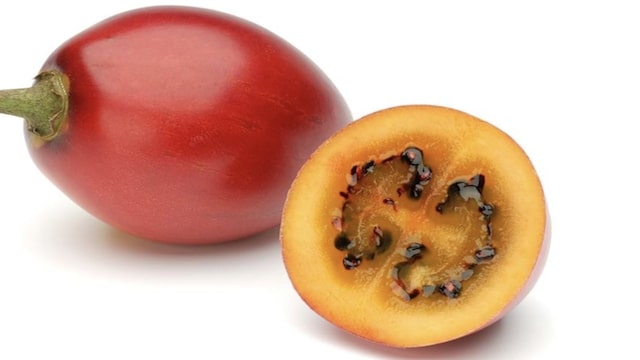
Also known as tree tomatoes, this exotic fruit originated from the Andes mountains, growing at an altitude of 1000 to 3000 meters. The appearance is small, duck-egg size, with orange-red skin.
They can be eaten raw, pickled, mixed with sauces, or made into a dessert. The flesh tastes sweeter, but the skin has a very bitter taste, so make sure to peel off the skin before eating the fruit.
It provides multiple health benefits, which are as follows:
- They are rich in antioxidants, proteins, dietary fiber, and vitamins.
- They are suitable for improving eyesight due to the richness in Vitamin A.
- They promote the health of the heart and kidney as well.
- They are proven to have anti-cancer properties.
Read Also – Top 10 Surprising Benefits Of Avocado For Hair, Skin And Health
5. Ice Cream Beans
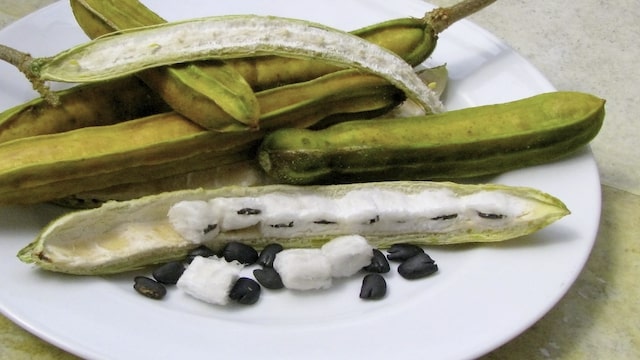
This exotic fruit is native to South America. The fruit appears to be like legumes, where the pods are about a foot long. It tastes like vanilla ice cream with the texture of cotton candy, and black seeds are spread throughout the pulp.
In Colombia, ice cream beans make an alcoholic beverage, ‘Cachiri,’ which is consumed at a festival. It offers many health benefits:
- The pulp is an excellent source of fibers and antioxidants.
- It helps to treat high cholesterol levels in the body.
- It helps to maintain healthy eyesight.
- It keeps the bones healthy and is suitable for the heart also.
4. Rambutan
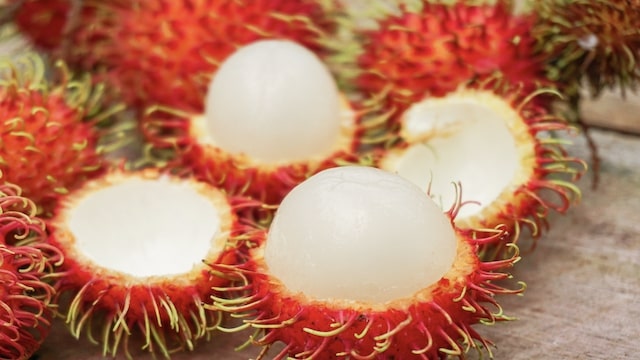
Native to Southeast Asia, this delicious fruit came from the Malaysian word ‘rambut,’ which means hair. It has pink hair outside with juicy white flesh inside, and the fruit has a sweet taste and contains seeds in the middle.
The nutritional benefits of Rambutan are:
- It has a good amount of copper, which helps to keep the bones, brain, and heart-healthy.
- It keeps the digestive system vital aids in weight loss.
- Rich in Vitamin C, this fruit helps fight infection and keeps the immune system strong.
- Some cells present in Rambutan can help prevent the growth and spread of cancer cells.
3. Melothria scabra

Native to Mexico and Central America, they are commonly known as ‘Cucamelon‘ or ‘Mouse Melon.’ The fruit looks like a tiny watermelon, about the size of a grape.
Despite being a fruit, it is not sweet but has a taste of a cucumber with a sour twist, like that of lemon. They can be eaten raw or even in salsas, salads, and cocktails.
The Health benefits of mouse melon are plenty. They are as follows:
- They are loaded with vitamins, fibers, and minerals, and they are low in calories.
- They help to maintain the heart’s health and prevent the development of cancer.
- Being high in potassium and Vitamin C, they help to keep cholesterol levels down.
- Rich in dietary fiber, they help reduce constipation as well.
2. Jabuticaba

Native to Southeastern Brazil, this rare and exotic fruit, unlike other fruits, grow on the tree’s trunk. They only grow in a subtropical climate where the tree can take six to eight years to bear the fruit; that is why it is so rare.
The fruit appears to be grape but has a thicker skin. The juicy white flesh has a sweet taste and a pleasant fragrance.
Having high nutritional value, this purple fruit can benefit you in multiple ways:
- This fruit is rich in antioxidants which inhibit the development and spread of cancer cells in the body.
- Jabuticaba has been used to treat diarrhea.
- It is rich in anti-inflammatory properties and helps prevent diseases like diabetes, arthritis, etc.
- It acts as a natural detox and is healthy for the liver.
- It is rich in Vitamins C and E, iron, potassium, and calcium.
1. Buddha’s Hand
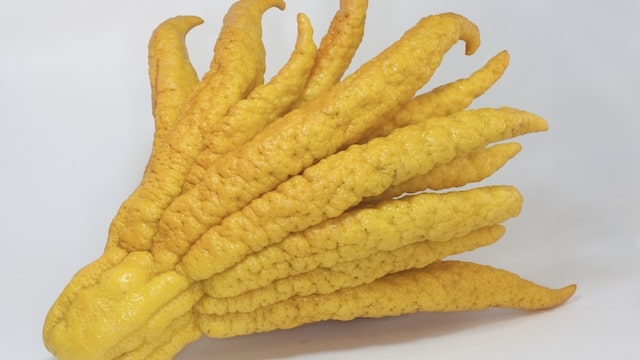
Buddha’s hand or ‘Fingered Citron’ or ‘Fo Shou’ is native to China and Northeast India. The fruit looks like a gnarled hand, resembling the hand of a praying Buddha.
Thus, it has been named so. The fruit tastes a bit tangy, like lemon, and has no seeds or juice. Though it has an odd shape, the fruit offers many nutritional benefits:
- In China, the fruit is used as a medicinal herb to treat diseases.
- Having anti-inflammatory properties, it is also used to relieve pain and menstrual cramps.
- The fruit is known to treat respiratory diseases.
- It keeps the digestive and immune systems strong.
- It lowers the level of cholesterol in the body, thus maintaining heart health as well.
The list does not end here. There are still many unique fruits to be eaten which might contain more health benefits than these. Loaded with vitamins, there is no doubt that fruits are best to maintain a healthy body.
These rare fruits are present on different continents and are cherished by everyone around the globe. If you eat these rare fruits every day, by your own choice, you’ll live a life free of health problems.





















Every fruits new to me. Thanks
tree tomato
Fruits
most of the fruit eaten like banana rambutan and manghusteen
amazing!
Niice
Super
Nice
Nice.
Very useful content
wow
Good information
rare
new and rare information
Informative
Find information
Like red banana
Wonderful fruits
Nice
Nice
Fruits is an essential in our human life. We should be protected our body. Healthy information. Move on.
Good
Yummy enough to eat them all
Informative article.
Good
Informative
Really
Amazing
Create
Good article
Nice one
Wonderful
Useful
Well
amazing
Informative
Fantastic
Great
Nice information
Correct
Yes
Superb